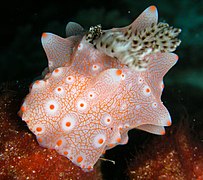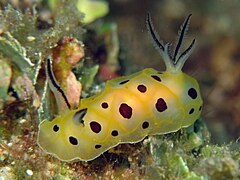Halgerda
| Halgerda | |
|---|---|

| |
| Halgerda stricklandi | |
| Scientific classification | |
| Domain: | Eukaryota |
| Kingdom: | Animalia |
| Phylum: | Mollusca |
| Class: | Gastropoda |
| Order: | Nudibranchia |
| Family: | Discodorididae |
| Genus: | Halgerda Bergh, 1880[1] |
| Type species | |
| Halgerda formosa Bergh, 1880
| |
Halgerda is a genus of sea slugs, dorid nudibranchs, shell-less marine gastropod mollusks in the family Discodorididae.
Taxonomy
The genus Halgerda was classified within the family Halgerdidae by Odhner (1934).[2] Halgerdidae Odhner, 1926, is treated as a synonym of Discodorididae in the taxonomy of Bouchet & Rocroi (2005).[3] See also Valdés (2002).[4] Seven species of Halgerda were described in the years 1880-1905, two species in 1932-1949, four species from 1975-1982, then 22 species in the years 1993-2001. In 2018 another six new species were described from Mozambique, highlighting the number of undescribed species on the African coast of the Indian Ocean.[5] A number of undescribed species are known and many species show considerable variation across their ranges, which may indicate that more cryptic species exist.[6]
Distribution
All species of Halgerda are confined to the Indo-West Pacific Tropical region apart from two species which are found in warm temperate waters of South Africa and Southern Australia and one species from warm temperate Japanese waters.
Species
Species within the genus Halgerda include:[7]
- Halgerda abyssicola Fahey & Gosliner, 2000
- Halgerda albocristata Fahey & Gosliner, 1999
- Halgerda aurantiomaculata (Allan, 1932)
- Halgerda azteca Fahey & Gosliner, 2000
- Halgerda bacalusia Fahey & Gosliner, 1999
- Halgerda batangas Carlson & Hoff, 2000
- Halgerda brunneomaculata Carlson & Hoff, 1993
- Halgerda brycei Fahey & Gosliner, 2001
- Halgerda carlsoni Rudman, 1978
- Halgerda dalanghita Fahey & Gosliner, 1999
- Halgerda diaphana Fahey & Gosliner, 1999
- Halgerda dichromis Fahey & Gosliner, 1999
- Halgerda elegans Bergh, 1905
- Halgerda fibra Fahey & Gosliner, 2000
- Halgerda formosa Bergh, 1880
- Halgerda graphica Basedow & Hedley, 1905
- Halgerda guahan Carlson & Hoff, 1993
- Halgerda gunnessi Fahey & Gosliner, 2001
- Halgerda indotessellata Tibiriçá, Pola & Cervera, 2018
- Halgerda jennyae Tibiriçá, Pola & Cervera, 2018
- Halgerda johnsonorum Carlson & Hoff, 2000
- Halgerda leopardalis Tibiriçá, Pola & Cervera, 2018
- Halgerda malesso Carlson & Hoff, 1993
- Halgerda maricola Fahey & Gosliner, 2001
- Halgerda meringuecitrea Tibiriçá, Pola & Cervera, 2018
- Halgerda mozambiquensis Tibiriçá, Pola & Cervera, 2018
- Halgerda nuarrensis Tibiriçá, Pola & Cervera, 2018
- Halgerda okinawa Carlson & Hoff, 2000
- Halgerda onna Fahey & Gosliner, 2001
- Halgerda orstomi Fahey & Gosliner, 2000
- Halgerda paliensis (Bertsch & Johnson, 1982)
- Halgerda punctata Farran, 1902
- Halgerda rubicunda Baba, 1949
- Halgerda stricklandi Fahey & Gosliner, 1999
- Halgerda terramtuentis Bertsch & Johnson, 1982
- Halgerda tessellata (Bergh, 1880) - originally as Dictyodoris tessellata Bergh, 1880
- Halgerda theobroma Fahey & Gosliner, 2001
- Halgerda toliara Fahey & Gosliner,1999
- Halgerda wasinensis Eliot, 1904
- Halgerda willeyi Eliot, 1904
- Halgerda xishaensis Lin, 1975
References
- ^ Bergh, L.S.R. 1880. Beiträge zur Kenntniss der japanischen Nudibranchien. I. Verhandlungen der königlich-kaiserlich Zoologisch-botanischen Gesellschaft in Wien (Abhandlungen) 30:155-200, pls. 1-5, pages 191-5.
- ^ Odhner N. H. (1934). "The Nudibranchiata, British Antarctic ("Terra Nova") Expedition, 1910". Natural History Report, Zoology 7(5): 229-310.
- ^ Bouchet, Philippe; Rocroi, Jean-Pierre; Frýda, Jiri; Hausdorf, Bernard; Ponder, Winston; Valdés, Ángel & Warén, Anders (2005). "Classification and nomenclator of gastropod families". Malacologia. 47 (1–2). Hackenheim, Germany: ConchBooks: 1–397. ISBN 3-925919-72-4. ISSN 0076-2997.
- ^ Valdés A. (2002). "A phylogenetic analysis and systematic revision of the cryptobranch dorids (Mollusca, Nudibranchia, Anthobranchia)". Zoological Journal of the Linnean Society 136: 535-636. doi:10.1046/j.1096-3642.2002.00039.x.
- ^ Tibiriçá, Y.; Pola, M.; Cervera, J. L. (2018). Systematics of the genus Halgerda Bergh, 1880 (Heterobranchia : Nudibranchia) of Mozambique with descriptions of six new species. Invertebrate Systematics.
- ^ Gosliner, T.M., Behrens,D.W. & Valdes,A., 2008. Indo-Pacific Nudibranchs and Sea Slugs. A field guide to the World's most diverse fauna. Sea Challengers Natural History Books & The California Academy of Sciences. ISBN 978-0-9700574-3-3
- ^ Bouchet, P.; Gofas, S. (2014). Halgerda Bergh, 1880. Accessed through: World Register of Marine Species at http://www.marinespecies.org/aphia.php?p=taxdetails&id=205320 on 2015-01-25













